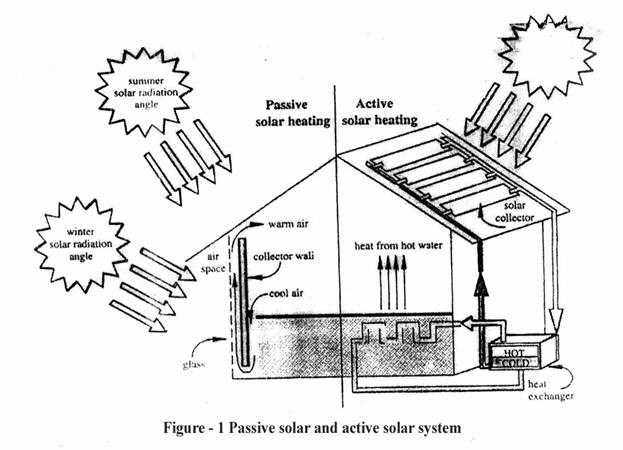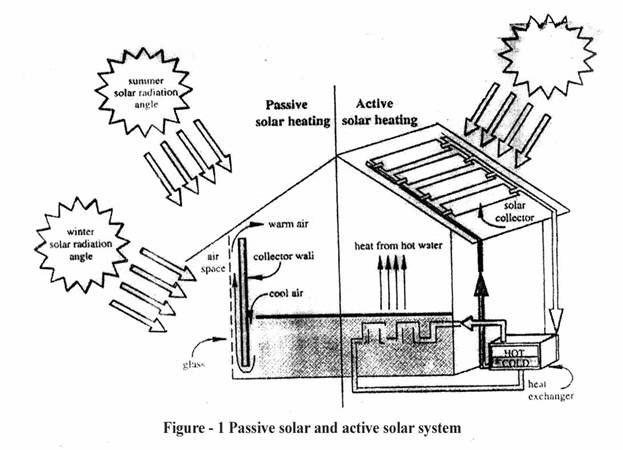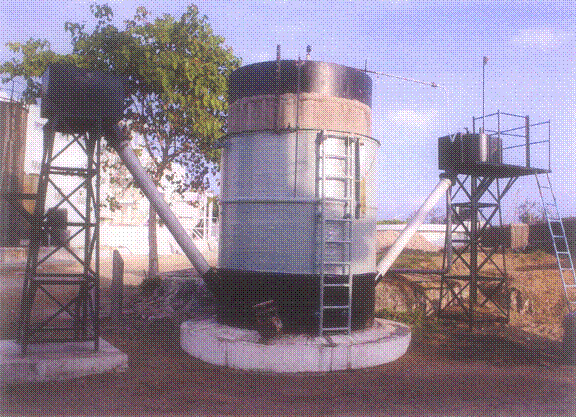S.No. |
Sources |
Potential |
Achievement |
| 1. | Wind | 45,000 | 2980 |
| 2. | Hydro Power Plant | 15,000 | 1700 |
| 3. | Biomass Power | 19,500 | 750 |
| 4. | Solar Panel | 20 mw/km 2 | 2mw/km 2 |
| 5. | Waste to Energy | 1700 mw | 50 mw |



| Theme: 10. Energy Conservation, Renewable Energy | Paper 1 | Paper 2 |
Renewable Energy Sources |
|||
| Presentation PDF | |||
| Abstract |
The sharp increase in energy consumption particularly in the past several decades has raised fears of exhausting the globe's reserves of petroleum and other resources in the near future. The huge consumption of fossil fuels has caused visible damage to the environment in various forms. Approximately 90% of our energy consumption comes from fossil fuels. Due to industrializations and population growth our economy and technologies today largely depend upon natural resources, which are not replaceable. World Energy Conservation predicted estimation about the rate of utilization of energy resources shows that the coal deposits will deplete within the next 200 to 300 years and petroleum deposits will deplete in next few decades. Now, the world is looking for alternate energy resources. Hence, it is necessary to encourage and emphasize the research and development activities covering a broad spectrum of possible renewable resources, as their contributions are substantial. Renewable Energy sources are not depleted. These resources are quickly renewed through natural process. It won't create any environmental pollution problems. The main advantage of using renewable resource is it is available throughout the year. By an one time investment we can drew energy for many decades without affecting the environment. Successful implementation of renewable energy sources our country economy is increased.
1.0 Introduction |
Power sector is one of the key sectors contributing significantly to the growth of country's economy. Power sector needs a more useful role to be played in defining, formulating and implementing the research projects with close involvement of all utilities such that the benefits reaches the ultimate consumer. Power sector being highly technologies intensive, Research and Development plays a major role in its developmental plans and to find solutions for the problems existing in the power systems. A Country largely depends on the thermal power generation and a right fuel mix, based on well-diversified portfolios of indigenous and imported fuel would be required. The another advantage using renewable resources is that they are distributed over a wide geographical area, ensuring that developing regions have access to electricity generation at a stable cost for the long-term future. This is not the case with fossil fuels in particular petroleum products.
The increase in energy consumption, particularly in the past several decades, has raised fears of exhausting the globes reserves of petroleum and other resources in the future. The huge consumption of fossil fuels has caused visible damage to the environment in various forms. Every year human activity dumps roughly 8 billion metric tons of carbon into the atmosphere, 6.5 billion tons from fossil fuels and 1.5 billion from deforestation [ 2 ] . It creates lot of environment problem and finally our ecological cycle will be affected. The energy industry needs to get more from existing fields while continuing to search for new resources. Due to technological advancement vehicles are made with improved fuel efficiency and also perfect hybrid vehicle are made. Also the improvements are needed so that wind, solar and hydrogen can be playing more valuable sources in the energy field. The Table - 1 shows world wide largest contributions to current energy sources.
At present so many alternative fuels have been developed, still they are able to meet only a small proportion of our actual demand. Lack of adequate technology and economical consideration to crap and store the renewable energies when they are in abundant supply is the area where we have to concentrate much. The production of fuel alternatives is projected to increase more than 2.5 times their current usage levels by year 2015. But even at this strong rate of growth, alternate fuels will be only 2.3% of total use at that time [ 4 ] .
2.0 Availability of Renewable Energy Resources |
Renewable Energy sources are not depleted, and it is distributed over a wide geographical area, These resources are quickly renewed through natural process. It won't create any environmental pollution problems. The main advantage of using renewable resource is it is available throughout the year. By an one time investment we can drew energy for many decades without affecting the environment.
2.1 Solar Energy:
Solar Energy has the greatest potential for providing clean, safe, and reliable power. The solar energy falling on the Earths continents is more than 200 times the total annual commercial energy currently being used by humans [ 1 ] . The government started solar power adoption with subsidies. A consumer who installs a solar panel array on a house can sell surplus energy to the local utilities. The solar panel cost, reduced to 50%, which would make solar Powered Electricity cost comparable with other types of fuel, is possible within the next decade [ 5 ] . Solar Energy can be classified as two types 1. Passive solar and 2. Active solar. Passive solar energy is making direct and indirect use of thermal energies from the sun. Indirect use of Energy is possible only in building (or) structures (as shown in Figure –1). A southern exposure of a building guarantees the maximum exposure of the sun's rays. Special metal leaf covering over windows and roofs can block out the sun during the summer months. Special thermal solar collectors can circulate water through the collection unit that collect the sun's thermal energy for the purpose of heating the water for use [ 1 ] . Active Solar Energy is the use of the sun's Electro magnetic radiation in generating Electrical Energy. Generally semi-conductor silicon Boron solar chips are used for this. The problem of these chips one that they have low Efficiency ratio and can only be used in supplying Energy needs of small devices (i.e. calculators, watches, radio etc.)
2.2 Wind Energy:
Wind, ultimately driven by atmospheric air, is just another way of collecting Energy. Sun also heats the atmosphere, which produces wind. It works on cloudy days and Rainy season also. The location of wind turbines is a very important factor, which influences the performance of the machine. The windmills are generally located at the top of a tower to heights approximately 30 m. To avoid turbulence from one turbine affecting the wind flow at others it is located at 5-15 times blades diameter. Windmills are working both in horizontal axis and vertical axis. The basic mechanics of the two systems are similar. Wind passing over the blades is converted in to mechanical power, which is fed through transmission to an electrical generator. Wind turbines will not work in winds below 13 km an hour. They work best where the wind speed averages 22 km an hour. The majority of wind turbines produced at the present time are horizontal axis turbine with three blades, 15-30 m diameter, producing 50-350 kW of Electricity. Wind energy produces no air or water pollution, involves no toxic or hazardous substances, and poses no threat to public safety.
2.3 Biomass Energy:
Biomass is the most important source for energy productions supplied by agriculture. Effective harnessing of bio-energy can energize entire rural milieu in a country like India where nature offers various types of biomass. This energy is also available in the form of biodegradable waste, which is the rejected component of available biomass [10]. Biomass energy refers to fuels made from plants and animal wastes. The Biomass resource is, organic matter in which the energy of sunlight is stored in chemical bonds. When the bonds between carbon, hydrogen and oxygen molecules are broken by digestion, combustion (or) decomposition these substances release stored energy. Biomass energy is generated when organic matter is converted to Energy. In alcohol fermentation, the starch in organic matter is converted to sugar by heating. This sugar is then fermented and finally ethanol is distiller and then blended with another fuel. An aerobic digestion converts biomass, especially waste product such as municipal solid waste and market waste. In this process, the facultative bacteria breakdown the organic material in the absence of oxygen and produce methane and carbon dioxide. . Bioconversion is a non-polluting, environmentally feasible and cost effective process [5]. The effluent and digester residues are rich in nitrogen and phosphorus, which can be recycled back to the soil as a fertilizer [6]. By using this method we can derive 70% of the energy. The biomass is mixed with water and stored in an airtight tank.
The organic wastes (Municipal Solid Waste) are collected separately and dried natural method and shredded to the maximum particle size of 2 – 4 mm. This was stored in a plastic container at room temperature and was characterized and it was used during all anaerobic digestion treatment. Domestic sewage was collected from a college campus before disposal. It was used in all anaerobic digestion experiment for diluting the feedstock to achieve the required total solids concentration for the present investigation. Experiments were carried out in 5 lit. Capacity batch type reactor operating in semi continuous mode with daily feeding. The digester was operated at room temperature at a constant hydraulic retention time of 25 days with different organic loading rate. To start with, the digester was initiated by charging with 2.75 lit. of feed stocks (2% TS) along with 2 lit. of feed sludge. The digester was maintained anaerobic ally and stabilization was to take place for two weeks. During this stabilization period, pH was maintained in the range of 6.5 to 7.5 by adding sodium hydroxide. The pH and gas production were measured every day. It was found that the maximum biogas production is 0.36m3/kg of VS added/day at the optimum organic loading rate of 2.9 kg of VS / m3/d.
In Chennai the government set up a power plant (as shown in Figure-.2) using vegetable waste as fuel. Daily 40 tones of market waste is going to be used for the power plant. The power plant will generate about 4800 units of electricity/day. The gas comprises 65% of methane and 35% of carbon di oxide, and is transferred into a gasholder and finally electrical energy is produced. The power generated from the plant will be sold at Rs.3.15/unit
2.4 Tidal Power:
Oceans cover Two Thirds of the Earth's surface. This water is vast reservoir of renewable energy. India is naturally located in seashore side and covered 3 sides by sea. The movement of the water at the coastal front in kinetic energy that can be converted into Electrical energy. The energy spread out along the thousand of km of coasts, in favorable location, the energy density can average 65 MW/mile of coastline an amount which can lead to economical wave generated Electricity. The cheapest method to draw tidal power is that the oscillating water columns use the force of waves entering a fixed device to generate Electricity. The waves entering the anchored compress air in a vertical pipe. This compressed air can be used to simply derive a turbine generator producing Electricity. The main problem of wave power plants is cyclone and severe storms. During this period the plant is not working.
3.0 Environmental Problems in Non-renewable Energy Resources: |
Fossil fuels are coal; oil and natural gas, have originated from the decomposition of organic matter in or on the Earth. Coal is the worst offender among fossil fuels in terms of CO2 per unit of energy generated. Industrialized countries generate 20% to 30% of their energy from coal. Petroleum is derived from rich organic molecules in the sediments form. It emits sulphur contents and carbon monoxide and finally leads Acid rain. Natural gas is combustible mixture of methane and other hydrocarbons. Methane is highly corrosive one. The fossil fuels are producing following gaseous pollutants in the atmosphere.
Carbon Dioxide is responsible for 55% of global warming. The main sources are fossil fuel burning (77%) and deforestation (23%). The Table – 2 shows the National ( India ) Ambient Air quality standards in Different Places.
Due to industrialization and population growth the increase in atmospheric Carbon di-oxide already presents nearly a 30% change in the world. Ultimately, this could increase the average global temperature by about 1 ° -5 ° C. Every year the average global surface temperature rises approximately 0.3 ° -0.6 ° C. The Nitrogen oxides are responsible for about 35% of acid rain [ 3 ] . Methane is responsible for about 20% of the green house effect. This is mainly emitted from burning of coal and natural gas leaks, natural gas associated with oil production and spillage of petrol. In Thermal power plants the coolant water is discharged into rivers (or) lakes. The water body suddenly increases the temperature and losing its oxygen holding capacity i.e., Dissolved oxygen is reduced, so it is directly affecting the aquatic organisms [ 6 ] .
4.0 Existing available renewable resources in India |
In limited available technology and economical consideration to trap and store the renewable energies when they are in abundant supply in the area where we have to concentrate much. The production of fuel alternatives is projected to increase more than 2.5 times their current usage levels by year 2015. But even at this strong rate of growth alternate fuels will be only 2.3% of Total use at that time [ 6 ] . The Table – 3 shows the New and Renewable sources of energy potential and cumulative achievement in India .
5.0 Economical Benefits |
Problems with renewable energy sources are non-availability at a reasonable cost, limited supplies and lack of cost Effective means for capturing and concentrating the renewable Energy. By Effective steps to eliminate these the importing of fossil fuel (oil and Natural gases) can be minimized the country's economy will increase [7]. The figure.3 shows the comparative cost in renewable and non-renewable energy sources.
The production cost of renewable source is reduced by subsidies. For some years, the World Bank has been sold Electricity in developing countries at an average only 40% of the cost of its production. The government by introducing subsidies in the form of relaxing duties, taxes and installation charges, the prices can be drastically reduced and it will came equal to fossil fuel rate [8].
6.0 Conclusion |
The renewable sources are cost effective, user-friendly, so that they can easily beat the fossil fuels. By promoting renewable energy sources we can avoid, Air pollution, soil pollution and water pollution. Country's Economy will increase. Throughout the year these sources are available without affecting the Environment.
7.0 References |
• Ashokverghese , New and Renewable Energy Resources, Proceedings of International conference on Alternate Energy resources, Asian Institute of Technology , Thailand , pp 403 - 410
• Malkivia – pyh I.G and Pyh Y.A, 2002, Sustainable energy Resources, Technology and Planning, WIT Press, Boston .
• Booth, D.E, 1998, The environmental consequences of Growth, London and New York ,
• Cline, W.R., 1992, The Economics of global warming, Washington D.C.
• Gibbons, J.H, et.al, 1989, Strategies for energy use, vol. 261, PP 136-143.
• Time Magazine, August 2005, PP 32-33.
• Journal of Innovations in Renewable Energy, June 2005Vol. 2, PP 24-25.
• National geographic magazine, August 2005.
• Popular Mechanics Magazine, September 2005.
• The Executive Engineer, Tamil Nadu Pollution Control Board , India .
• Renewable energy magazine, Ministry of Non-conventional Energy Sources, Government Of India, Vol.1, Auguest 2005, PP 17-18 .
• S.Sivanesan, Production of Biogas from Municipal Solid Waste with Domestic Sewage, Journal of
Hazardous Material , (Article in press).
Table – 1 World wide largest contributions of Energy resources
S.No. |
Sources |
Available in (%) |
| 1. | Oil | 31 |
| 2. | Coal | 26 |
| 3. | Natural Gas | 19 |
| 4. | Hydro Electricity | 6 |
| 5. | Firewood & Crop waste | 12 |
Table – 2 National ( India ) Ambient Air quality standards
| S.No. | Pollutants | Time-Weighted Average | Concentration in Ambient Air ( m g/m 3 ) | ||
| Industrial Areas | Residential Areas | Sensitive Areas | |||
| 1. | Sulphur Dioxide |
Annual average | 80 |
60 |
15 |
| (SO 2 ) | 24 Hrs. | 120 |
80 |
30 |
|
| 2. | Oxides of Nitrogen | Annual average | 80 |
60 |
15 |
| (NOx) | 24Hrs | 120 |
80 |
30 |
|
| 3. | Carbon Monoxide | 8 Hrs. | 5 |
2 |
1 |
| (CO) | 1 Hrs. | 10 |
4 |
2 |
|
Table – 3 New and Renewable sources in India
S.No. |
Sources |
Potential |
Achievement |
| 1. | Wind | 45,000 | 2980 |
| 2. | Hydro Power Plant | 15,000 | 1700 |
| 3. | Biomass Power | 19,500 | 750 |
| 4. | Solar Panel | 20 mw/km 2 | 2mw/km 2 |
| 5. | Waste to Energy | 1700 mw | 50 mw |




• Name : D.Elango
• Qualification : B.E. (Civil Engg.), M.E. (Envir. Engg.), (Ph.d)
• Designation : Assistant Professor in Civil Engg.,
Hindustan College of Engg.,
Chennai- 603 103
• On going Research Activity : Municipal Solid Waste Management at Anna University
• No. of Paper published in International Journals : 3
• No. of Paper published in International Conferences : 11
• No. of paper published in National Conferences : 5
• Awards : Best paper presentation at P.S.G. College of Tech. , Coimbatore , Tamil Nadu
• Country Visited : Parriys , Malaysia and Singapore
1. Professor, Department of Automobile Engg., Hindustan College of Engg., Padur-603 103, Tamil Nadu.
2* Asst.Professor, Department of Civil Engg., Hindustan College of Engg., Padur- 603 103, Tamil Nadu E-mail Id: gangaduraielango@hotmail.com
![]()